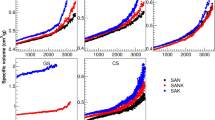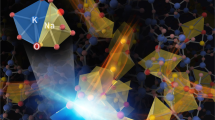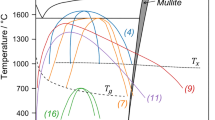Abstract
The most common of man-made glasses have aluminosilicate compositions, and such glasses also form from rapidly cooling magmas1. Oxygen is the most abundant element in these materials, where it occupies either ‘bridging’ (BO) or ‘non-bridging’ (NBO) sites. BOs link two AlO4 or SiO4 tetrahedra, thereby providing strong, long-lived bonds between the smallest structural units of the aluminosilicate network. NBOs provide a relatively weak connection between one tetrahedral cation (Al or Si) and one or more network modifier cations — such as Ca2+or Na+ — that are not an integral part of the tetrahedral network. The relative abundance of these weakly bonded NBOs is critical in determining the thermodynamic and dynamical properties of aluminosilicate glasses and melts1,2,3. For glasses of ‘tectosilicate’ composition, where the charge of the modifier cation equals the number of aluminium atoms (as in NaAlSi3O8 or CaAl2Si2O8), the conventional view of glass structure is that only BOs are present1,4. Here we present experimental observations that contradict this view. Our NMR measurements of CaAl2Si2O8, which determine directly the relative abundances of BO and NBO, indicate that a considerable amount of NBO can be present in a tectosilicate glass. These excess NBOs will increase the entropy and heat capacity of the corresponding liquid and decrease its viscosity, as well as modifying flow and diffusion mechanisms2,3. As the most common rhyolitic magmas and the molten precursors of glass ceramics have near-tectosilicate compositions1,4, our results require a reassessment of the high-temperature liquid properties that control many processes in the Earth and in industry.
This is a preview of subscription content, access via your institution
Access options
Subscribe to this journal
Receive 51 print issues and online access
$199.00 per year
only $3.90 per issue
Buy this article
- Purchase on Springer Link
- Instant access to full article PDF
Prices may be subject to local taxes which are calculated during checkout



Similar content being viewed by others
References
Mysen, B. O. Structure and Properties of Silicate Melts (Elsevier, Amsterdam, (1988)).
Richet, P. & Neuville, D. R. in Thermodynamic Data (ed. Saxena, S. K.) (Springer, New York, (1992)).
Stebbins, J. F. in Structure, Dynamics, and Properties of Silicate Melts (eds Stebbins, J. F., McMillan, P. F. & Dingwell, D. B.) (Mineralogical Society of America, Washington DC, (1995)).
Navrotsky, A. Physics and Chemistry of Earth Materials (Cambridge Univ. Press, (1994)).
Riebling, E. F. Structure of sodium aluminosilicate melts containing at least 50 mol% SiO2at 1500 °C. J. Chem. Phys. 44, 2857–2865 (1966).
Bottinga, Y. & Weill, D. F. The viscosity of magmatic silicate liquids: a model for calculation. Am. J. Sci. 272, 438–475 (1972).
Weill, D. F., Hon, R. & Navrotsky, A. in Physics of Magmatic Processes (ed. Hargraves, R. B.) (Princeton University Press, Princeton, NJ, (1980)).
Taylor, M. & Brown, G. E. J Structure of mineral glasses — I. The feldspar glasses NaAlSi3O8, KAlSi3O8, CaAl2Si2O8. Geochim. Cosmochim. Acta 43, 61–75 (1979).
Mysen, B. O., Virgo, D. & Seifert, F. A. The structure of silicate melts: implications for chemical and physical properties of natural magma. Rev. Geophys. Space Phys. 20, 353–383 (1982).
Murdoch, J. B., Stebbins, J. F. & Carmichael, I. S. E. High-resolution 29Si NMR study of silicate and aluminosilicate glasses: the effect of network-modifying cations. Am. Mineral. 70, 332–343 (1985).
Merzbacher, C. I., Sherriff, B. L., Hartman, J. S. & White, W. B. Ahigh resolution 29Si and 27Al NMR study of alkalineg earth aluminosilicate glasses. J. Non-Cryst. Solids 124, 194–206 (1990).
Toplis, M. J. & Dingwell, D. B. Viscosity maxima of melts close to the ‘charge balanced’ join in the systems (Na2O, CaO, MgO)–Al2O3–SiO2: implications for the structural role of aluminium. Eos Trans. Am. Geophys. Un. 77, F848 (1996).
Toplis, M. J., Dingwell, D. B. & Lenci, T. Peraluminous viscosity maxima in Na2O–Al2O3–SiO2liquids: the role of triclusters in tectosilicate melts. Geochim. Cosmochim. Acta 61, 2605–2612 (1997).
Farnan, I. et al. Quantification of the disorder in network modified silicate glasses. Nature 358, 31–35 (1992).
Florian, P., Vermillion, K. E., Grandinetti, P. J., Farnan, I. & Stebbins, J. F. Cation distribution in mixed alkali disilicate glasses. J. Am. Chem. Soc. 118, 3493–3497 (1996).
Kirkpatrick, R. J. in Spectroscopic Methods in Mineralogy and Geology (ed. Hawthorne, F. C.) (Mineralogical Society of America, Washington DC, (1988)).
Oglesby, J. V., Xu, Z. & Stebbins, J. F. Non-bridging oxygen order and disorder in mixed alkaline earth silicate glasses. Eos Trans. Am. Geophys. Un. 77, F834 (1996).
Stebbins, J. F., Ogelsby, J. V. & Xu, Z. Disorder among network modifier cations in silicate glasses: new constraints from triple-quantum oxygen-17 NMR. Am. Mineral. (in the press).
Frysman, L. & Harwood, J. S. Isotropic spectra of half-integer quadrupolar spins from bidimensional magic-angle spinning NMR. J. Am. Chem. Soc. 17, 5367–5368 (1995).
Baltisberger, J. H., Xu, Z., Stebbins, J. F., Wang, S. & Pines, A. Triple-quantum two-dimensional 27Al magic-angle spinning nuclear magnetic resonance spectroscopic study of aluminosilicate and aluminate crystals and glasses. J. Am. Chem. Soc. 118, 7209–7214 (1996).
Dirken, P. J., Kohn, S. C., Smith, M. E. & van Eck, E. R. H. Complete resolution of Si–O–Si and Si–O–Al fragments in an aluminosilicate glass by 17O multiple quantum magic angle spinning NMR spectroscopy. Chem. Phys. Lett. 266, 568–574 (1997).
Xue, X., Stebbins, J. F. & Kanzaki, M. Correlations between O-17 NMR parameters and local structure around oxygen in high-pressure silicates and the structure of silicate melts at high pressure. Am. Mineral. 79, 31–42 (1994).
Xu, Z. & Stebbins, J. F. NMR study of oxygen isotope exchange in stilbite. Eos Trans. Am. Geophys. Un. 77, F827 (1996).
Xu, Z. & Stebbins, J. F. Oxygen sites in the zeolite, stilbite: a comparison of static, MAS, VAS, DAS, and triple quantum MAS NMR techniques. Solid State NMR (in the press).
McMillan, P. A. Raman study of glasses in the system CaO–MgO–SiO2, Am. Mineral. 69, 645–659 (1984).
Farnan, I. & Stebbins, J. F. Ahigh temperature 29Si NMR investigation of solid and molten silicates. J. Am. Chem. Soc. 112, 32–39 (1990).
Xue, X., Stebbins, J. F., Kanzaki, M., McMillan, P. F. & Poe, B. Pressure-induced silicon coordination: NMR, Raman, and infrared spectroscopy. Am. Mineral. 76, 8–26 (1991).
Massiot, D. et al. Two-dimensional magic-angle spinning isotropic reconstruction sequences for quadrupolar nuclei. Solid State NMR 6, 73–84 (1996).
Acknowledgements
We thank R. Jones (Stanford Centre for Materials Research) for the microprobe analyses. This work was funded by the US National Science Foundation.
Author information
Authors and Affiliations
Corresponding author
Rights and permissions
About this article
Cite this article
Stebbins, J., Xu, Z. NMR evidence for excess non-bridging oxygen in an aluminosilicate glass. Nature 390, 60–62 (1997). https://doi.org/10.1038/36312
Received:
Accepted:
Issue Date:
DOI: https://doi.org/10.1038/36312
This article is cited by
-
Crystallization Behavior, Viscosity and Structure of CaO–SiO2–MgO–(15~30 Mass Pct) Al2O3 Melts Representing the Oxide Inclusions in Si-Killed Steel
Metallurgical and Materials Transactions B (2024)
-
Effect of TiO2 Addition on the Viscosity of Ladle Refining Slags
Metallurgical and Materials Transactions B (2024)
-
Phase separation in mullite-composition glass
Scientific Reports (2022)
-
Octahedral oxide glass network in ambient pressure neodymium titanate
Scientific Reports (2022)
-
Transparent ferroelectric glass–ceramics for wastewater treatment by piezocatalysis
Communications Materials (2020)
Comments
By submitting a comment you agree to abide by our Terms and Community Guidelines. If you find something abusive or that does not comply with our terms or guidelines please flag it as inappropriate.



